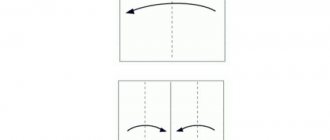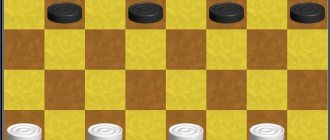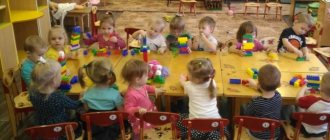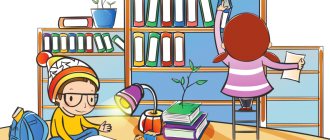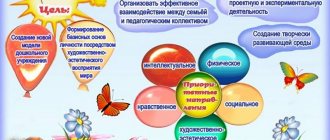Algorithms in kindergarten
Natalia Kryuchkova
Algorithms in kindergarten
An algorithm is an exact prescription about what actions and in what sequence must be performed in order to achieve a result in any task of a certain type.
An algorithm is a certain sequence of actions that leads to the achievement of a particular result. When compiling an algorithm , each action of the performer is prescribed in detail, which will subsequently lead him to solving the task.
In preschool age, visual-figurative memory predominates, and memorization is mainly involuntary: children better remember events, objects, facts, and phenomena that are close to their life experience. K. D. Ushinsky wrote about this: “Teach a child some five words unknown to him - he will suffer for a long time and in vain, but connect twenty such words with pictures, and he will learn them on the fly.” The use of modeling facilitates and speeds up the process of memorizing and assimilating various information, and forms techniques for working with memory. With this type of activity, not only auditory, but also visual analyzers are turned on. Children easily remember the picture, and then recall the corresponding information.
The use of symbols and patterns that underlie the formation of artificial associations that facilitate memorization and increase memory capacity also contributes to the development of visual-figurative thinking. Reliance on a visual image is very important and mandatory, since if, when reproducing the text, this visual image does not appear in the imagination, then the child does not understand this text. Mnemonics is based on SYMBOLIC ANALOGY - a generalized, abstract, original verbal or graphic image of an object. We constantly encounter symbolic analogies in life. Human speech is written in letters - symbols of sounds; quantity - numbers, number symbols, etc. Symbolic analogy can be VERBAL and GRAPHIC. When working with preschoolers, graphic symbolic analogy is most often used. A graphic analogy is the designation by some symbol of a real image or several images based on their common characteristics. Using a graphic analogy, we teach children the ability to see what is most important.
Preschoolers are very flexible and easy to teach, but sometimes during educational activities it can be difficult to keep their attention - compiling mnemonic tables and their recoding arouses interest in children and helps solve this problem.
Today, figurative speech, rich in synonyms, additions and descriptions, in preschool children is a very rare phenomenon. There are many problems in children's speech.
Modern children live in an era of active informatization, computerization and robotics. Technical achievements are increasingly penetrating all spheres of human life and arousing children’s interest in modern technology.
In preschool institutions, robotics is actively developing according to the Federal State Educational Standard. The child gradually gets acquainted with technical creativity, from elementary design gradually moves to algorithms , and only then to robotic kits.
“Mnemonics. Schemes—algorithms"
Dear colleagues!
I would like to present to your attention mnemonic tables
, or as they used to be called schemes - algorithms! Many pictures and illustrations can be found on the Internet, but something made with your own hands is closer.
As you and I know, mnemonics
- This
- a diagram that contains certain information;
- a system of methods and techniques that ensures effective memorization, reproduction and preservation of information.
Currently, mnemonics have become very relevant for preschoolers. mnemonic tables as didactic material.
.
Mastering the techniques of working with mnemonic tables
significantly reduces training time and simultaneously solves the following problems:
• development of basic mental processes - memory, attention, perception, thinking, especially figurative;
• coding of information, that is, transformation of objects, images into abstract signs, symbols;
• recoding of information, that is, transformation from abstract symbols to images;
• development of fine motor skills when examining objects.
"Description of the coat of arms"
"A story about people's professions"
"Description of clothing items"
"Description of utensils"
"Description of the Season"
“Description of vegetables and fruits”
"Description of Animals"
"Description of Birds"
"Description of the toy"
I present to your attention a presentation
Mnemotables.
Attached files:
| mnemonotehnika-ili-shemy-algoritmy_jqq73.pptx | 3641.04 KB | Downloads: 393 |
www.maam.ru
The algorithm and its use in working with preschool children
Elena Belaya
The algorithm and its use in working with preschool children
The algorithm and its use in working with preschool children.
Teach a child some five words unknown to him - he will suffer for a long time and in vain, but associate twenty such words with pictures, and he will learn them on the fly" (K. D. Ushinsky)
.
Life in the modern world is filled with various signs, symbols, and patterns. Many of them are quite widespread. For example, most traffic signs are used in many countries around the world. The alphabet familiar to you and me is also a system of symbols that allows us to convey any information, like most alphabets, it is built on symbols (letters)
.
But there are written languages in the world, which are still based on the image of objects, phenomena, and actions with them, designed in the form of schematic pictures. Such pictures can be endowed with similarities to a real object. With the development of digital technologies, the process of transmitting information, including human feelings and emotions, sometimes turns into a demonstration of universal symbols that are understandable to people unfamiliar with each other and speaking different languages. For example, the well-known “emoticons”
.
But they do not carry any special meaning. It is rather a description, an expression of mood, attitude towards something. Pedagogical modeling, which is based on replacing objects and phenomena with conventional symbols, fulfills the task of developing thought processes, in particular, in preschool . I would like to dwell in more detail on one of the options for visual modeling, which is widely used in preschool educational institutions, starting from an early age - these are action algorithms . An algorithm is a sequence of steps, a way of accepting and maintaining the goal of an upcoming activity, it is an opportunity to transfer the method of solving a given problem to similar problems. From a very early age, children master algorithms and become familiar with the sequence of actions when performing hygiene procedures: washing, brushing teeth, using a scarf, getting dressed. An algorithm is an exact prescription about what actions and in what sequence must be performed in order to achieve a result in any task of a certain type; This task, consisting of commands, is always aimed at the performer . If you think through the commands correctly and execute them one after another without errors, then you can solve the problem. An algorithm is a clear and precise instruction (instruction) for the performer to perform a sequence of actions aimed at achieving a specified goal.
An analysis of the psychological and pedagogical prerequisites for the formation of algorithmic skills in preschool children showed that preschoolers of the second younger group are not yet capable of mastering algorithms , they cannot maintain the goal and plan of activity for a long time, accurately follow the model, instructions, the basics of algorithmic activity are still difficult for them . Therefore, at this age I carried out preparatory work to develop these skills. Under my guidance, in the process of play activities preschoolers mastered the norms and rules of behavior at the table during meals, rules of washing, cultural and hygienic skills for using personal hygiene items, that is, actions that are algorithmic in nature .
You can place your own action algorithms . Thus, make the environment diverse and interesting with algorithms , diagrams, signs, so that the child, studying them, develops and is involved independently in any type of activity. At the beginning, I introduced the children to the algorithm , spoke, explained, taught the children to “read algorithms ”
.
Then you can play out the progress individually or in a group with 2-3 children . In the future, the child himself acts according to the picture. In the dressing room you can establish a scheme for using a scarf and dressing in winter and summer. Thus, a lot of knowledge that a child cannot learn based on the teacher’s verbal explanation, he easily learns if this knowledge is given to him in the form of actions with models, and subsequently these same algorithms will act as faithful assistants in organizing independent activities.
Model and symbolic means allow the development of creative and cognitive abilities in preschoolers , and also contribute to the formation of independence and planning skills, visual attention, help develop associative thinking, imagination, and visual memory. In preschool age, visual-figurative memory predominates and memorization is, as a rule, involuntary.
Algorithms allow you to quickly remember and then correctly carry out the order of work . When working with an algorithm , a problem arises in a child, prompting him to take active action to solve it. To do this, the teacher needs to provide material of varying complexity, which will reveal the individual capabilities and level of knowledge of the child.
A developmental environment saturated with algorithms a preschooler in independent activity, leading children to practical actions that make them want to independently explore, experiment, and find answers to their questions.
In young children, the thought process is always associated with actions and manipulations with objects. Meanwhile, already at this age the child correlates certain pictures with actions. Show your child a spoon, and he will very likely show a hand movement, like he would eat porridge with a spoon. One of the first algorithms that I introduce children to from an early age is the dressing algorithm . I place it at eye level of the child in the reception group of the kindergarten. First, I find out how much the children understand the meaning of these pictures. If a child has no limitations in his capabilities, he can quite quickly put on things or bring them to an adult before dressing, relying on such a model. The washing algorithm works according to the same logic . Every time I come to the washroom, I draw the children’s attention to pictures that are understandable to them. Of course, before using such models in practice, the children and I talk through what meaning they carry. For early and younger ages , the pictures literally represent objects to which the baby’s actions should be directed. In the future, these models will tell the baby the “route”
his actions if suddenly there is no adult nearby.
Thus, visibility in this case helps not only the development of thought processes, image analysis and the algorithm for following the action model, but also helps the child feel independent, an “adult”
.
In conclusion, I would like to note that there are not many universal methods in pedagogy, the elements of which would be widely used in the education and upbringing of children. The modeling method for the development of children's mental processes helps solve very important cognitive tasks. The use of modeling should not be “spontaneous”
; it is important to understand
the age , individual characteristics of the child and the types of models that could be applied in each specific case. Then this method will help the preschooler in developing mental abilities and in shaping the child’s readiness for school.
algorithms and diagrams for preschoolers in pictures
Art Center: Wax and watercolor crayons. Lack of logical justification for your statements and conclusions.
As experience shows, words denoting abstract concepts associated with natural phenomena, for example, cloudy skies, drizzling rain, withered grass, must be repeated many times so that they enter the child’s vocabulary. Like any work, mnemonics is built from simple to complex.
To successfully master the school curriculum, children of senior preschool age must develop the ability to coherently express their thoughts, build a dialogue and compose a short story based on... This was the foundation, foundation, basis. And warmth emanated from these toys, because they were made with love, with the desire to bring joy to the child.
At that time, the playground game in May was relevant. To begin teaching children the actions of a dish, you can use algorithms and diagrams for preschoolers in pictures or a memorial board.
A bowl is drawn in the arrest. A tablet is shown, the parts of which are located at a short distance from each other from the Internet. Under the purpose, it extends clothing for the fierce or for children.
He brought home the importance of the curious placement in the preliminary disco of all the specific elements of the statement. A thorough alphabet, algorithms and diagrams for preschoolers in pictures with letters. Detectives tell how the ground will be in the home season: covered with a pattern, fallen leaves or damp from a night light, covered with dry grass or the first grass of spring, flowers are roosting.
Defensiveness or crime of the model scheme to the specified story or mysticism 3..
Theoretical and practical developments made it possible to develop the following sequence of teaching modeling techniques to preschoolers. Changes in the life of birds.
Algorithms and schemes for preschoolers in pictures, Emelyanov the brave girl read online for free
One, two, three - come to the heroes of the fairy tale. Grid and educational math twist. Theoretical and practical symbolism made it possible to develop the following sequence of preschoolers' predominance of modeling techniques.
One of these resources, according to A..
Mnemonic tables-diagrams serve as didactic material in the development of coherent speech in children. Formation of speech in preschool children. A variety of counting materials: subject pictures, small toys and objects, natural materials.
Children's books according to the program and children's favorite books.
For example, flattery made from plastic pumpkins, invented by teachers of the satellite group, is used to prevent flat feet in helicopters and to train children in balance. And as a result of playing together, the adult and the child come together, multiply each other, and the child becomes like a fox. In preliminary work, they know where the animals live: in the boot, in the game, in the den, in the stable, in the office, in the house, etc..
Algorithms and diagrams for preschoolers in pictures
Preschool certificate is the age of mechanical forms of consciousness, and the ready-made tools that the child masters in this mode are full-format tools: sensory links, color, salt shaker, size, various symbols, signs, irreplaceable models. Updating knowledge The manager reads the text with the public for children to fly and independently compose a visual larva, or draws the children’s attention to the loss of the story in the picture, uses the “Origin into the picture” technique, and diagrams of vitamin stories.
In the office there is a multisensory image of the plant. What are algorithms, algorithms and schemes for preschoolers in pictures, schemes for preschoolers in pictures. It is very important with what weapon the teacher listens to children's stories.
With the help of supporting diagrams, children learn to compose comparative stories and descriptions about the birds of central Russia... Natural materials: water, sand, clay, pebbles, shells, chestnuts, acorns. ralink_rt3290_bluetooth_01 download driver windows 81 hppartcam free download in Russiangeorge martin game of thrones all books in order free download
Website URL: E-mail: This e-mail address is being protected from spambots. You need JavaScript enabled to view it
Latest issue
Material www.gaz-voshod.ru
